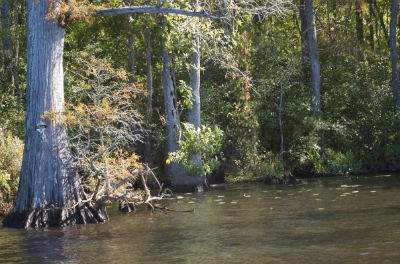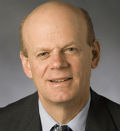First of two parts
RALEIGH — The annual round of grant applications to the state’s Clean Water Management Trust Fund topped out at 161 this year, just over the 160 requests in 2011.
Supporter Spotlight
They’re spread throughout the state: 53 in the western counties, 49 in the central and 57 in the east. Most would match local and, sometimes, federal government money. If all the requests were funded, the total amount of grants would be just shy of $125 million.

This tract along the Chowan River is among the thousands of acres along the coast that have been preserved with grants from the N.C. Clean Water Management Trust Fund. Photo: Clean Water Management Trust Fund |
But next month when the trust fund’s board of directors settle down to decide what to fund, they won’t have anywhere near that amount of money to work with. State allocations to the fund have dropped precipitously over the past three years and for the second year in a row it is operating with the lowest annual allocation in its 16-year history, just $11.25 million of the $100 million annual contribution required in the statutes.
It was no surprise that the fund took a hit in the budget. Trust funds are an oft-used source when the legislature is looking to fill budget gaps. Early last year, one of the surest indications of what the newly constituted N.C. General Assembly might slice into was the governor’s budget proposal, which in many cases served as a starting point for deeper cuts and at the very least indicated the low-hanging fruit where the executive and legislative branches could find agreement.
Gov. Beverly Perdue’s proposal was similar to the prior biennium proposing to take half of the fund’s annual $100 million target, the same amount cut the previous year. Budget writers in the legislature had a different number in mind.
Supporter Spotlight
Cuts Draw Fire
When the $11.25 million annual appropriation was announced it drew considerable fire from the mountains to the coast, especially from conservation groups worried about the future of acquisition and protection of wetlands, critical waterways and shellfish habitats. Acquisition of critical lands for water quality often in tandem with conservation groups has been a major focus of the fund throughout its history, representing about half of its about 1,400 grants.
But conservationists weren’t the only people raising alarms. Local governments seeking trust fund grants to leverage local money for improvements to sewage treatment facilities and other water quality projects were also concerned, not just over the funding levels but whether it signaled a change in direction in state policy.
Writing in the UNC School of Government’s Economic Development blog after the budget passed, Jeff Hughes, director of the school’s Environmental Finance Center, said there’s a growing debate over who pays for water quality improvements — the local water system’s rate payers or the public at large.
“Whether the developments this summer have more to do with budget realities than philosophical debates about who should pay remains to be seen, but the trends are worth watching,” he wrote.

Richard Rogers |
Richard Rogers, the trust fund’s executive director, said reductions in funding in tight budget years are a given, but the cut in this budget cycle is unprecedented and will greatly limit what the fund can do. If levels stay this low, the fund could be in trouble.
“I don’t think that the program can sustain itself with where we are now,” he said.
Getting funding back in the $40 million to $50 million range, he said, is a top priority, but just as important is getting legislators to allow the fund’s board more flexibility.
A provision included in the budget spelled out for the first time how and where the trust fund must spend its money. Of the $11.25 million, $3 million was to be spent on administration and debt service, $1.5 million on buffer acquisition around military bases and $6,750,000 on water infrastructure and conservation easements.
No Acquisitions
Last year, with 160 project application from all over the state, the trust fund board not only had to greatly winnow down the number of projects that could be funded, but also make sure they fit into the new criteria. Rogers said one result was that the cuts effectively halted almost all land acquisition except for areas near military property.
And of the 46 wastewater projects seeking roughly $67 million, only 16 made the cut at a total cost of $6.8 million. Of the $29 million in restoration and stormwater projects, $3.9 million were funded.
Rogers said the cuts have had a natural impact on staffing and he’s had to reduce his workforce by 43 percent. Beyond the numbers, he said, the reductions and the proscription for using funds substantially changed what the board could do. It ruled out larger projects and, most importantly, it limited the criteria.
“The provision took away the ability to assess projects’ impact on water quality,” Rogers said.
Since its inception, he said, the fund has used a competitive grant process and has looked for the most bang for the buck when it comes to protecting the state’s surface water. Acquisition of key lands, often in cooperation with conservation and outdoors groups, has been one of the most effective ways to accomplish that. The budget provision made that difficult if not impossible.
Rogers said this year, the focus has been on conservation easements, which are permitted under the provision, rather than outright acquisition. That’s led to a boost in funding to mini-grants,” which cover the administrative and legal costs landowners encounter when they want to donate land.
Going forward, Rogers said, the fund and its supporters are trying to win back its flexibility and some of the funds it lost, an effort that recently won the support of more than 100 sporting and outdoor groups statewide who urged legislators to restore the fund to at least $40 million.
Rogers said he sees some headway in convincing legislators, particularly as the new leadership in the legislature settles into its role.
He and fund supporters are also working to overcome some partisan perceptions of the trust fund’s work. Last year, he said, the trust fund unfortunately got caught up in some of the backlash against programs associated with former Senate President Pro Tem Marc Basnight, who championed the concept in the mid-1990s in the wake of disastrous fish kills in the Neuse River.
“We’re trying to dismiss the idea that this program was a Basnight program and we put money where he wanted us to put money,” Rogers said.
Wrong Direction

Bill Holman |
Bill Holman, a former trust fund executive director, said Basnight may have been the fund’s champion, but notes that when it passed in 1996 the General Assembly was divided, with Democrats controlling the Senate and Republicans running the House. The way the fund was set up, he said, was designed to reduce the amount of politics involved.
“The genius behind the idea was the competitive grant process,” he said, “not the legislature proscribing what some community needs, but the community coming up with it, whether that’s wastewater, stormwater, land conservation or oyster bed restoration — whatever’s the high priority.”
Holman, who served as executive director from 2001 to 2005, said the fund has developed a careful set of criteria and a working knowledge of issues and needs throughout the state. To try and narrow what it can do now is the wrong course, he said.
“I think it was a mistake for the legislature to put in the provision,” Holman said.
At a time when water quality is probably more important now than it’s ever been and when water quantity is a growing concern, Holman said reducing the fund’s resources and its flexibility are is the wrong directions.
“I really hope to see some new funding and also hope the legislature takes away the restrictions and lets them find the best projects,” he said. “What’s wrong with funding the best projects?”
Tuesday: Some coastal projects that the trust fund made possible.







